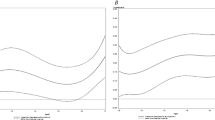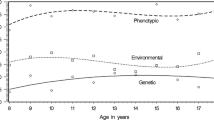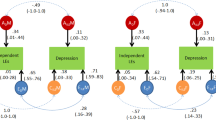Abstract
Although the Swedish Adoption Twin of Aging (SATSA) has been used to investigate phenotypic stability of late life depressive symptoms, the biometric processes underlying this stability have not been studied. Under a reciprocal effects modeling framework, we used SATSA twins’ Center for Epidemiologic Studies Depression (CES-D) Scale data across 5 waves (from 1987–2007) to test whether the reciprocal exchange between twins within a family and their nonshared environments (P<=>E) promote the accumulation of gene-environment correlation (rGE) over time. The model generates increasing rGE that produces subsequent stable environmental differences between twins within a family—a process hypothesized to explain stability in chronic late life depressive symptoms. Widowhood is included as a stressful life experience that may introduce an additional nonshared source of variability in CES-D scores. Genetic effects and nonshared environmental effects are primary sources of stability of late life depressive symptoms without evidence of underlying rGE processes. Additionally, widowhood explained stable differences in CES-D scores between twins within a family up to 3 years after spousal loss.





Similar content being viewed by others
References
Alexopoulos GS (2005) Depression in the elderly. Lancet 365(9475):1961–1970
Beam CR, Turkheimer E (2013) Phenotype-environment correlations in longitudinal twin models. Dev Psychopathol 25(1):7–16
Beekman ATF, Geerlings SW, Deeg DJ, Smit JH, Schoevers RS, de Beurs E et al (2002) The natural history of late-life depression. Arch Gen Psychiatry 59(2002):605–611
Blazer DG (2003) Depression in late life: review and commentary. J Gerontol A Biol Sci Med Sci 58(3):249–265
Bonanno GA, Wortman CB, Lehman DR, Tweed RG, Haring M, Sonnega J et al (2002) Resilience to loss and chronic grief: A prospective study from preloss to 18-months postloss. J Pers Soc Psychol 83(5):1150–1164
Bonanno GA, Wortman CB, Nesse RM (2004) Prospective patterns of resilience and maladjustment during widowhood. Psychol Aging 19(2):260–271
Boomsma DI, Molenaar PCM (1987) The genetic analysis of repeated measures. I simplex models. Behav Genet 17(2):111–123
Browne MW, Cudeck R (1992) Alternative ways of assessing model fit. Soc Methods Res 21(2):230–258
Bruce ML (1980) Depression and disability in late life: directions for future research. Adv Pathobiol 7:247–248
Bruce ML (2002) Psychosocial risk factors for depressive disorders in late life. Biol Psychiatry 52:175–184
Burnham KP, Anderson DR (2004) Multimodel inference: understanding AIC and BIC in model selection. Soc Methods Res 33(2):261–304
Carmelli D, Swan GE, Kelly-Hayes M, Wolf PA, Reed T, Miller B (2000) Longitudinal changes in the contribution of genetic and environmental influences to symptoms of depression in older male twins. Psychol Aging 15(3):505–510
Core Team R (2014) R: a language and environment for statistical computing. R Foundation for Statistical Computing, Vienna
De Kort J, Dolan C, Kan KJ, van Beijsterveldt C, Bartels M, Boomsma D (2014) Can GE-covariance originating in phenotype to environment transmission account for the Flynn Effect? J Intell 2(3):82–105
Dickens WT, Flynn JR (2001) Heritability estimates versus large environmental effects: the IQ paradox resolved. Psychol Rev 108(2):346–369
Dickens WT, Turkheimer E, Beam CR (2011) The social dynamics of the expression of genes for cognitive ability. In: Kendler KS, Jaffee S, Romer D (eds) The dynamic genome and mental health: The role of genes and environments in youth development. Oxford, New York, pp 103–127
Dolan CV, de Kort JM, van Beijsterveldt TCEM, Bartels M, Boomsma DI (2014) GE Covariance through phenotype to environment transmission: an assessment in longitudinal twin data and application to childhood anxiety. Behav Genet 44(3):240–253
Eaves LJ, Krystyna L, Martin NG, Jinks JL (1977) A progressive approach to non-additivity and genotype-environmental covariance in the analysis of human differences. Brit J Math Stat Psy 30:1–42
Eaves LJ, Long J, Heath AC (1986) A theory of developmental change in quantitative phenotypes applied to cognitive development. Behav Genet 16(1):143–162
Finkel D, Pedersen NL (2004) Processing speed and longitudinal trajectories of change for cognitive abilities: the Swedish Adoption/Twin Study of Aging. Aging, Neuropsychol, Cognit 11(2–3):325–345
Fiske A, Gatz M, Pedersen NL (2003) Depressive symptoms and aging: the effects of illness and non-health-related events. J Gerontrol 58(6):320–328
Fiske A, Wetherell JL, Gatz M (2009) Depression in older adults. Annu Rev Clin Psychol 5:363–389
Galatzer-Levy IR, Bonanno GA (2012) Beyond normality in the study of bereavement: heterogeneity in depression outcomes following loss in older adults. Soc Sci Med 74(12):1987–1994
Gatz M, Pedersen NL, Plomin R, Nesselroade JR, McClearn GE (1992) Importance of shared genes and shared environments for symptoms of depression in older adults. J Abnorm Psychol 101(4):701–708
Guttman L (1954) Some necessary conditions for common-factor analysis. Psychometrika 19:149–161
Hertzog C, Alstine JV, Usala PD, Hultsch DF, Dixon R (1990) Measurement properties of the Center for Epidemiological Studies Depression Scale (CES-D) in older populations. Psychol Assess 2(1):64–72
Jaffee SR, Price TS, Reyes TM (2013) Behavior genetics: past, present, future. Dev Psychopathol 25:1225–1242
Kendler KS, Baker JH (2007) Genetic influences on measures of the environment: a systematic review. Psych Med 37:615–626
Kendler KS, Prescott CA (1999) A population-based twin study of lifetime major depression in men and women. Arch Gen Psychiatry 56:39–44
Kline RB (2005) Principles and practice of structural equation modeling, 2nd edn. Guilford Press, New York
Lee GR, DeMaris A (2007) Widowhood, gender, and depression: a longitudinal analysis. Res Aging 29(1):56–72
Lichtenstein P, Gatz M, Pedersen NL, Berg S, McClearn GE (1996) A co-twin-control study of response to widowhood. J Gerontrol 51B(5):P279–P289
Lucas RE, Clark AE, Georgellis Y, Diener E (2003) Reexamining adaptation and the set point model of happiness: reactions to changes in marital status. J Pers Soc Psychol 84(3):527–539
Martin-Matthews A (2011) Revisiting widowhood in later life: changes in patterns and profiles, advances in research and understanding. Can J Aging 30(3):339–354
McArdle JJ, Prescott CA (2005) Mixed-effects variance components models for biometric family analyses. Behav Genet 35(5):631–652
McDonald RP (1999) Test theory: a unified treatment. Lawrence Erlbaum Associates, Mahwah
McGue M, Christensen K (2003) The heritability of depression symptoms in elderly Danish twins: occasion-specific versus general effects. Behav Genet 33(2):83–93
McGue M, Christensen K (2013) Growing old but not growing apart: twin similarity in the latter half of the lifespan. Behav Genet 43:1–12
Muthén BO, Kaplan D (1985) A comparison of some methodologies for the factor analysis of non-normal Likert variables: a note on the size of the model. Br J Math Stat Psychol 38:171–189
Muthén LK, Muthén BO (1998–2012) Mplus user’s guide. Muthén and Muthén, Los Angeles
Neale MC, Cardon LR (1992) Methodology for genetic studies of twins and families. Springer, Netherlands
Neiss M, Almeida DA (2004) Age differences in the heritability of mean and intraindividual variation of psychological distress. Gerontology 50(1):22–27
Osler M, McGue M, Lund R, Christensen K (2008) Marital status and twins’ health and behavior: an analysis of middle-aged Danish twins. Psychosom Med 70(4):482–487
Radloff LS (1977) The CES-D scale: a self-report depression scale for research in the general population. Appl Psychol Meas 1(3):385–401
Raykov T (2005) Analysis of longitudinal studies with missing data using covariance structure modeling with full-information maximum likelihood. Struct Equ Model 12(3):493–505
Satorra A, Bentler PM (2001) A scaled difference Chi square test statistic for moment structure analysis. Psychometrika 66(4):507–519
Shafer AB (2006) Meta-analysis of the factor structures of four depression questionnaires: beck, CES-D, Hamilton, and Zung. J Clin Psychol 62(1):123–146
Wetherell JL, Gatz M, Pedersen NL (2001) A longitudinal analysis of anxiety and depressive symptoms. Psychol Aging 16(2):187–195
Acknowledgments
This work was supported by the National Institute of Child Health and Human Development (1R01HD056354-01) and the National Institute on Aging (1F31AG044047-01A1 and T32AG020500).
Conflict of Interest
None.
Human and Animal Rights and Informed Consent
This report does not contain any studies with animals performed by any of the authors. Informed consent was obtained from all individual participants included in the study.
Author information
Authors and Affiliations
Corresponding author
Electronic supplementary material
Below is the link to the electronic supplementary material.
Rights and permissions
About this article
Cite this article
Beam, C.R., Emery, R.E., Reynolds, C.A. et al. Widowhood and the Stability of Late Life Depressive Symptomatology in the Swedish Adoption Twin Study of Aging. Behav Genet 46, 100–113 (2016). https://doi.org/10.1007/s10519-015-9733-7
Received:
Accepted:
Published:
Issue Date:
DOI: https://doi.org/10.1007/s10519-015-9733-7




